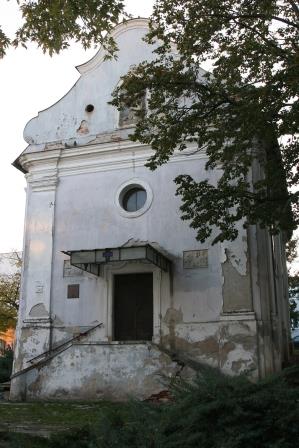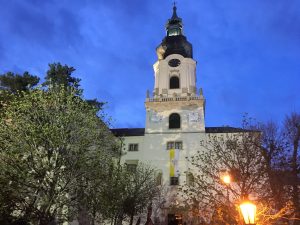Nitra (26. apríla) Rímskokatolícka cirkev Biskupstvo Nitra vyhlasuje výberové konanie na obsadenie funkcie riaditeľa Cirkevnej základnej umeleckej školy sv. Lukáša v Topoľčanoch.
Viac informácií tu:
Nitra (26. apríla) Rímskokatolícka cirkev Biskupstvo Nitra vyhlasuje výberové konanie na obsadenie funkcie riaditeľa Cirkevnej základnej umeleckej školy sv. Lukáša v Topoľčanoch.
Viac informácií tu:
.
Pri realizácii projektu bola pôvodná fasáda kostolíka očistená mechanicky ako aj pomocou chemického čistenia. Boli odstránené nevhodné konštrukčné prvky. Tvarovo, remeselným spracovaním a technickým stavom nevyhovujúca oceľová markíza nad vstupom do kostola bola na mieste rozpílená, a deinštalovaná.
Hmota nesúdržných pôvodných omietok, kamenného portálu a sochy sv. Michala Archanjela bola spevnená. Na omietanie boli použité minerálne omietky, s cieľom dosiahnuť poréznosť a pevnosť s originálom. Pri tmelení bolo dôležité rešpektovať zámer na reštaurovanie, postupne rekonštruovať zaniknutú profiláciu ríms, a ostatných prvkov. Rozsah rekonštrukcie určuje využitie pamiatky a konečná úprava, štuková omietka bola nanesená a hladená na povrch starších kompaktných omietok na celom povrchu plášťa objektu. Na doplnenie a domodelovanie chýbajúcich častí kamennej hmoty bol použitý tmel na minerálnej báze Cieľom tmelenia bolo dosiahnuť poréznosť materiálov, štruktúru povrchu a pevnosť tmelu totožnú s originálom. Omietané časti boli ošetrené jednou vrstvou náteru na báze silikátu. Druhá vrstva bude aplikovaná v jarných mesiacoch v roku 2017.
Farebné zjednotenie tmelov (na kamennom portáli a soche sv. Michala Archanjela) s originálom bolo realizované lazúrnymi farbami a prírodnými hlinkami.

1. Cleaning: the secondary adjustments, specified in the opening statements, will be eliminated from the surface of the plaster. The cleaning was realised mostly by mechanical means considering condition of older layers. Cement plaster and seals were removed, stonework was cleaned of dust and impurities.
2. Preservation: the plaster was fixed in places where it was released from the coating ground.
3. Plastering, float plastering: following the implementation project it was necessary to apply the remediation plaster approximately up to the height of crown of the arch borders. In places where the older plasters were not preserved, cement plasters were applied. These were completely removed. To the stonework, the remediation system was applied in the required thickness. On the prepared coating ground float plasters were applied. The float plasters structurally match the required surface.
4. Colour retouching, surface adjustments: full-area partly transparent coat of paint was applied by adding lime paint with light-stable pigments.
5. Recording: All the procedures were recorded in detail and in both, writing and pictures over the course of the restoration.
During the restoration, the secondary plaster layers were eliminated up to the layer originating in the third quarter of the 18th century.
It is a secondary baroque adjustment of the vault which is very similar to the original layer and it is preserved in very good condition. After removing these layers, preserved fragments of the original layer were discovered. The newer plaster layer does not overlap the original one. It is only connected to it and unified in colour. After cleaning, the condition was consulted with the representatives from KPÚ Banská Bystrica. These experts decided not to present analogous wound probes and barings, on the contrary, after preservation of older layers it was decided to unify the whole space with a new float plaster with a white (broken white) lime coating. Restoration execution was carried out in accordance with the implementation project in which the conditions and application of remediation system were clearly defined.
As the presence of the original Renaissance plaster was confirmed the restoration proposal included its revealing thereby the plan was to eliminate secondary adjustments, sealing of cracks in plaster layer as well as a colour retouching. Restoration execution was carried out in accordance with the implementation project in which the conditions and application of remediation system were clearly defined.
1. Cleaning: All the secondary adjustments were removed from the plaster surface. The cleaning was done by mechanical means considering the condition of Renaissance layer of the plaster. The newer layers of plaster were cut off on the all constructions approximately up to the height of the vault borders. The purpose was to apply remediation system in the required thickness.
2. Preservation: In the places where the plaster was released from the coating ground it was fixed by lime grout.
3. Cementing: Decline of the original plaster layer was fixed by refilling using a lime-based cement. The plaster surface was united into a single structured surface.
4. Colour retouching: Retouching was carried out by adding lime paint with light-stable pigments.
5. Recording: All the procedures were recorded in detail and in both, writing and pictures over the course of the restoration.
Keďže sa potvrdila prítomnosť pôvodnej renesančnej omietky jej úpravy, návrh na reštaurovanie zahŕňal jej prezentáciu a teda odstránenie sekundárnych úprav, zacelenie prasklín tejto omietkovej vrstvy a tiež farebnú retuš. Reštaurátorská realizácia bola realizovaná v súlade s realizačným projektom, kde boli jasne stanovené podmienky a aplikácia sanačného systému.
1. Čistenie: Z povrchu omietky boli odstránené všetky sekundárne úpravy. Čistenie bolo vykonané mechanickým spôsobom s ohľadom na stav renesančnej vrstvy. Na všetkých zvislých konštrukciách boli cca do výšky nábehov klenby osekané vrstvy mladších omietok. Cieľom bolo aplikovanie sanačného systému v potrebnej hrúbke.
2. Konzervovanie: V miestach, kde bola omietka uvoľnená od podkladu, bola fixovaná injektážnou maltou na vápennej báze.
3. Tmelenie: Úbytky pôvodnej omietkovej vrstvy boli doplnené tmelom na vápennej báze, povrch omietky bol zjednotený do jednotne štrukturovaného povrchu.
4. Farebná retuš: Retuš bola realizovaná vápennym náterom s pridaním svetlostálych pigmentov.
5. Dokumentácia: Všetky stavy počas priebehu reštaurovania boli písomne a fotograficky zdokumentované.
1. Čistenie: z povrchu omietky budú odstránené, v úvode bližšie špecifikované sekundárne úpravy. Čistenie bolo vykonané prevažne mechanickým spôsobom s ohľadom na stav starších vrstiev. Cementové omietky a plomby boli odstránené, murivo bolo zbavené prachu a nečistôt.
2. Konzervovanie: v miestach kde bola omietka uvoľnená od podkladu bola fixovaná.
3. Omietanie, gletovanie: podľa realizačného projektu bolo nutné aplikovať sanačnú omietku cca do výšky nábehu záklenku. Na miestach kde sa staršie omietkové vrstvy nezachovali, boli v minulosti použité cementové omietky. Tie boli odstránené až na murivo, kde bol sanačný systém aplikovaný v odporúčanej hrúbke. Na pripravený podklad boli realizované gletované omietky tak, aby povrch svojou štruktúrou zodpovedal požadovanému povrchu.
4. Farebná retuš, povrchová úprava: celoplošný čiastočne transparentný náter bol realizovaný vápenným náterom s pridaním svetlostálych pigmentov.
5. Zdokumentovanie priebehu: všetky stavy počas priebehu reštaurovania boli písomne a fotograficky zdokumentované.
Počas reštaurovania boli odstránené sekundárne vrstvy, až po vrstvu z tretej štvrtiny 18. storočia. Ide o sekundárnu barokovú úpravu klenby, ktorá je svojim charakterom veľmi podobná originálnej vrstve a je zachovaná v pomerne dobrom stave. Po odstránení týchto vrstiev sa na klenbe objavili zachované fragmenty originálnej vrstvy, ktoré novšia vrstva omietky neprekrýva, iba sa k nej napája a zjednocuje farebne. Po očistení bola realizovaná konzultáciu skutkového stavu so zástupcami KPÚ Banská Bystrica, ktorý rozhodol o neprezentovaní analogických sond a odkryvov, naopak bolo po konzervovaní straších vrstiev odsúhlasené zjednotenie celého priestoru novou gletovanou omietkou, opatrenou bielým (lomená biela) vápenným náterom. Reštaurátorská realizácia bola realizovaná v súlade s realizačným projektom, kde boli jasne stanovené podmienky a aplikácia sanačného systému.
